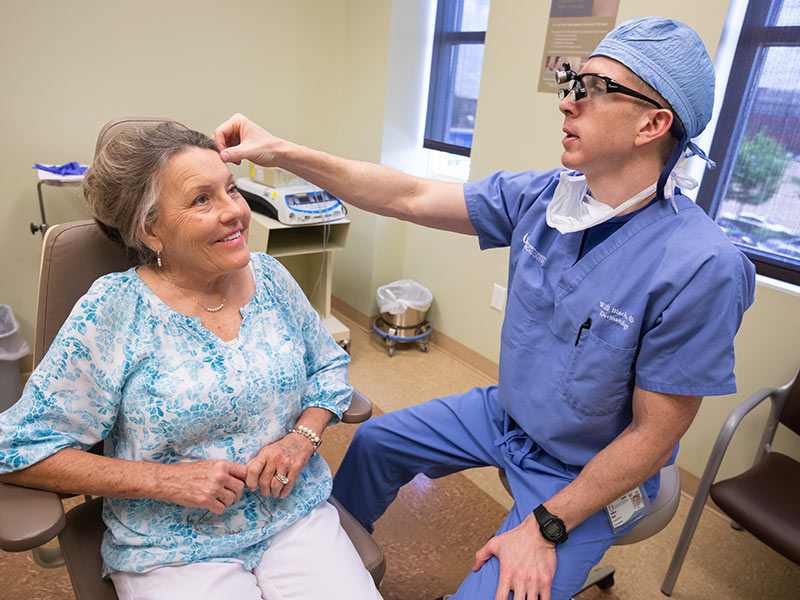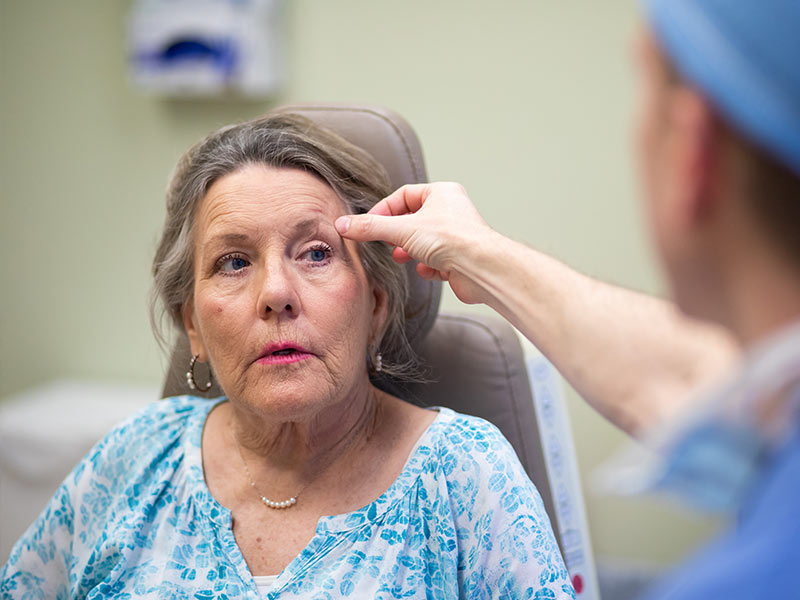Mohs surgery leaves few signs of melanoma

You might say vanity saved Linda Puckett’s life.
For about 20 years, she had used cosmetics to cover a small sunspot, in her left eyebrow and forehead.
“It was flat, not noticeable,” the Ludlow resident said.
In the spring, she mentioned the spot to her dermatologist, as he removed some smaller basal cell cancers from her arm and hands. It didn’t look or act like a cancer, so they agreed he’d freeze it. But it stubbornly remained and a biopsy followed.
The diagnosis: melanoma and a referral to Dr. William Black, an associate professor of dermatology and a Mohs surgeon on the University of Mississippi Medical Center Interdisciplinary Skin Cancer team. Black, one of only a few Mohs surgeons nationwide who uses the technique to remove melanoma in situ, a very early stage melanoma, said the skin-sparing procedure is best for cancers on the head and neck, hands and genitals.
Several Mississippi dermatologists use Mohs on nonmelanoma skin cancers such as basal and squamous cell carcinoma.
Puckett was surprised by her diagnosis. “I’ve never been a sun worshiper, but I have been in the sun a lot. I usually wore caps or hats on my head. This was in my eyebrow, about the size of a dime. It had been there for years.”
Black said the story is not uncommon.
“It looked like a sun spot,” he said. Catching it early before it exhibited traditional signs of a cancer was fortunate. It’s unlikely it was always malignant, but doctors have no way to determine when it became a melanoma. She was a good candidate for Mohs surgery, Black said.
Mohs surgeons use special equipment to remove thin layers of skin then look at it under a microscope to be sure the margins, or edges, are clear of cancer. If not, they can remove more layers to get it all. Additional surgical and pathology equipment is needed to do the same surgery for melanoma.
“The main idea is you are checking for margins. With the standard way of excising things, you’re actually checking a small percent of the margin for cancer,” Black said. “With Mohs, doctors are looking at the complete margin. Because you’re looking at 100 percent of the margin, you can cut a smaller amount of tissue which generally leaves a smaller scar.
“If you have a positive margin, in real time, you see that. You’re not bringing these patients back another day to remove more cancer,” he said.
A Mohs surgery team removes the skin, prepares it, stains it with chemicals so malignant cells are highlighted, looks for malignant cells and seeks margins that have only normal cells. If the margins show malignant cells, they return and remove another layer of tissue and repeat the process.
Puckett said she’s pleased with the results and shows photos of the early stitches and continued healing.

Today, a faint scar and a bit of puckered tissue under the eyebrow are all that remain. Black said those are likely to fade further. If they don’t, another short procedure can help.
The hardest part, was waiting, she said. The entire procedure took about five hours.
“That was the only unpleasant thing, and knowing I had this gaping hole in my head,” she said and laughed.
Black had removed skin about the diameter of a 50-cent piece, she said. She had to remain seated with the wound covered while he looked at the slides. Then doctors sutured the wound.
“He made a lot of stitches,” she said. “It was a big place on my head and into my eyelid.”
Today, more than six months later, she said it’s healed. “People that know I’ve had that done say ‘I can’t even see a scar,’” she said.
For Puckett’s primary dermatologist, Dr. Patrick Boler of Magnolia Dermatology in Clinton, the question was simple. His patient would benefit from Mohs surgery for melanoma, a service he doesn’t offer, and he knew Black would take care of his patient.
Her medical follow up procedure includes doctor visits every six months for the next three years to be sure no more melanomas appear.
Her personal schedule? “I use sunscreen and long-sleeve shirt if I’m going out for any length of time. I feel like the damage is already there. All I can do now is use good sense and go from there.”
Tips to lessen your risk of skin cancers:
- Wear broad-brimmed hats.
- Stay in the shade from 10 a.m. to 2 p.m. when ultraviolent rays are strongest.
- Wear sun screens with sun protection factors of SPF 30 or higher, also labeled broad spectrum UVA-UVB blockers.
- Reapply sun screens every two to three hours, especially if you are swimming or sweating.
- Wear sunglasses with UV protection.
- Check your body on the first day of every month for new growths, changing moles or sores that will not heal. Find a partner who can check your back.


